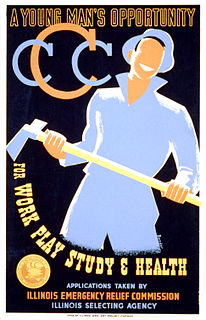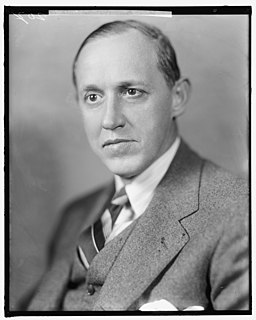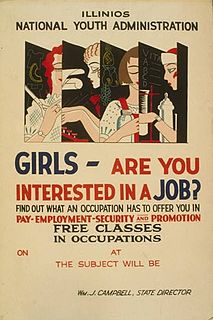
The Civilian Conservation Corps (CCC) was a voluntary private work relief program that ran from 1933 to 1942 in the United States for unemployed, unmarried men ages 18–25 and eventually expanded to ages 17–28. Robert Fechner was the first director of this agency, succeeded by James McEntee following Fechner's death. The CCC was a major part of President Franklin D. Roosevelt's New Deal that supplied manual labor jobs related to the conservation and development of natural resources in rural lands owned by federal, state, and local governments. The CCC was designed to supply jobs for young men and to relieve families who had difficulty finding jobs during the Great Depression in the United States. The largest enrollment at any one time was 300,000. Through the course of its nine years in operation, three million young men took part in the CCC, which provided them with shelter, clothing, and food, together with a wage of $30 per month.

Public Works Administration (PWA), part of the New Deal of 1933, was a large-scale public works construction agency in the United States headed by Secretary of the Interior Harold L. Ickes. It was created by the National Industrial Recovery Act in June 1933 in response to the Great Depression. It built large-scale public works such as dams, bridges, hospitals, and schools. Its goals were to spend $3.3 billion in the first year, and $6 billion in all, to supply employment, stabilize buying power, and help revive the economy. Most of the spending came in two waves in 1933–35, and again in 1938. Originally called the Federal Emergency Administration of Public Works, it was renamed the Public Works Administration in 1935 and shut down in 1944.

The Civil Works Administration (CWA) was a short-lived job creation program established by the New Deal during the Great Depression in the United States to rapidly create mostly manual-labor jobs for millions of unemployed workers. The jobs were merely temporary, for the duration of the hard winter of 1933–34. President Franklin D. Roosevelt unveiled the CWA on November 8, 1933, and put Harry L. Hopkins in charge of the short-term agency.

The Works Progress Administration was an American New Deal agency, employing millions of jobseekers to carry out public works projects, including the construction of public buildings and roads. It was set up on May 6, 1935, by presidential order, as a key part of the Second New Deal.

The Federal Writers' Project (FWP) was a federal government project in the United States created to provide jobs for out-of-work writers during the Great Depression. It was part of the Works Progress Administration (WPA), a New Deal program. It was one of a group of New Deal arts programs known collectively as Federal Project Number One or Federal One. The FWP employed thousands of people and produced hundreds of publications, including state guides, city guides, local histories, oral histories, ethnographies, and children's books. In addition to writers, the project provided jobs to unemployed librarians, clerks, researchers, editors, and historians.

Federal Project Number One, also referred to as Federal One, is the collective name for a group of projects under the Works Progress Administration, a New Deal program in the United States. Of the $4.88 billion allocated by the Emergency Relief Appropriation Act of 1935, $27 million was approved for the employment of artists, musicians, actors and writers under the WPA's Federal Project Number One. In its prime, Federal Project Number One employed up to 40,000 writers, musicians, artists and actors because, as Secretary of Commerce Harry Hopkins put it, "Hell, they’ve got to eat, too". This project had two main principles: 1) that in time of need the artist, no less than the manual worker, is entitled to employment as an artist at the public expense and 2) that the arts, no less than business, agriculture, and labor, are and should be the immediate concern of the ideal commonwealth.

The Federal Emergency Relief Administration (FERA) was a program established by President Franklin Roosevelt in 1933, building on the Hoover administration's Emergency Relief and Construction Act. It was replaced in 1935 by the Works Progress Administration (WPA).

Harry Lloyd Hopkins was an American statesman, public administrator, and presidential advisor. A trusted deputy to President Franklin Delano Roosevelt, Hopkins directed New Deal relief programs before serving as the 8th United States Secretary of Commerce from 1938 to 1940 and as Roosevelt's chief foreign policy advisor and liaison to Allied leaders during World War II. During his career, Hopkins supervised the New York Temporary Emergency Relief Administration, the Federal Emergency Relief Administration, the Civil Works Administration, and the Works Progress Administration, which he built into the largest employer in the United States. He later oversaw the $50 billion Lend-Lease program of military aid to the Allies and, as Roosevelt's personal envoy, played a pivotal role in shaping the alliance between the United States and the United Kingdom.

The Federal Theatre Project was a theatre program established during the Great Depression as part of the New Deal to fund live artistic performances and entertainment programs in the United States. It was one of five Federal Project Number One projects sponsored by the Works Progress Administration, created not as a cultural activity but as a relief measure to employ artists, writers, directors, and theater workers. It was shaped by national director Hallie Flanagan into a federation of regional theaters that created relevant art, encouraged experimentation in new forms and techniques, and made it possible for millions of Americans to see live theatre for the first time. Although The Federal Theatre project consumed only 0.5% of the allocated budget from the WPA and was widely considered a commercial and critical success, the project became a source of heated political contention. Congress responded to accusations of racial integration and Communism infiltration and cancelled its funding as of June 30, 1939.

The Resettlement Administration (RA) was a New Deal U.S. federal agency created May 1, 1935. It relocated struggling urban and rural families to communities planned by the federal government. On September 1, 1937, it was succeeded by the Farm Security Administration.

In the United States, the Great Depression began with the Wall Street Crash of October 1929. The stock market crash marked the beginning of a decade of high unemployment, poverty, low profits, deflation, plunging farm incomes, and lost opportunities for economic growth as well as for personal advancement. Altogether, there was a general loss of confidence in the economic future.

The National Youth Administration (NYA) was a New Deal agency sponsored by Franklin D. Roosevelt during his presidency. It focused on providing work and education for Americans between the ages of 16 and 25. It operated from June 26, 1935 to 1939 as part of the Works Progress Administration (WPA) and included a Division of Negro Affairs headed by Mary McLeod Bethune who worked at the agency from 1936 to 1943. Following the passage of the Reorganization Act of 1939, the NYA was transferred from the WPA to the Federal Security Agency. In 1942, the NYA was transferred to the War Manpower Commission (WMC). The NYA was discontinued in 1943.
The Second New Deal is a term used by historians to characterize the second stage, 1935–36, of the New Deal programs of President Franklin D. Roosevelt. In his address to Congress in January 1935, Roosevelt called for five major goals: improved use of national resources, security against old age, unemployment and illness, and slum clearance, national work relief program to replace direct relief efforts. It included programs to redistribute wealth, income, and power in favor of the poor, the old, farmers and labor unions. The most important programs included Social Security, the National Labor Relations Act, the Banking Act of 1935, rural electrification, and breaking up utility holding companies. The Undistributed profits tax was only short-lived. Liberals in Congress passed the Bonus Bill of $1.5 million to 3 million World War veterans over FDR's veto. Liberals strongly supported the new direction, and formed the New Deal Coalition of union members, big city machines, the white South, and ethnic minorities to support it; and conservatives—typified by the American Liberty League—were strongly opposed. Few liberal programs were enacted after 1936; liberals generally lost control of Congress in 1938. Programs continued for a while. Many were ended during World War II because unemployment was no longer a problem. These included the WPA, NYA and the Resettlement Administration. Social Security and the Wagner Act, however, would survive.

The recession of 1937–1938 was an economic downturn that occurred during the Great Depression in the United States.

The New Deal was a series of programs, public work projects, financial reforms, and regulations enacted by President Franklin D. Roosevelt in the United States between 1933 and 1939. Major federal programs and agencies included the Civilian Conservation Corps (CCC), the Civil Works Administration (CWA), the Farm Security Administration (FSA), the National Industrial Recovery Act of 1933 (NIRA) and the Social Security Administration (SSA). They provided support for farmers, the unemployed, youth and the elderly. The New Deal included new constraints and safeguards on the banking industry and efforts to re-inflate the economy after prices had fallen sharply. New Deal programs included both laws passed by Congress as well as presidential executive orders during the first term of the presidency of Franklin D. Roosevelt.

The Frazier–Lemke Farm Bankruptcy Act was an Act of Congress passed in the United States in 1934 that restricted the ability of banks to repossess farms.

The first 100 days of Franklin D. Roosevelt's presidency began on March 4, 1933, the day Franklin D. Roosevelt was inaugurated as the 32nd president of the United States. He had signaled his intention to move with unprecedented speed to address the problems facing the nation in his inaugural address, declaring: "I am prepared under my constitutional duty to recommend the measures that a stricken nation in the midst of a stricken world may require." Roosevelt's specific priorities at the outset of his presidency were getting Americans back to work, protecting their savings and creating prosperity, providing relief for the sick and elderly, and getting industry and agriculture back on their feet.

The Workers Alliance of America (WAA) was a Popular Front era political organization established in March 1935 in the United States which united several efforts to mobilize unemployed workers under a single banner. Founded by the Socialist Party of America (SPA), the Workers Alliance was later joined by the Unemployed Councils of the USA, a mass organization of the Communist Party USA (CPUSA), and by the National Unemployed Leagues originating with A.J. Muste's Conference for Progressive Labor Action (CPLA) and successor organizations.

The first term of the presidency of Franklin D. Roosevelt began on March 4, 1933, when he was inaugurated as the 32nd president of the United States, and the second term of his presidency ended on January 20, 1941, with his inauguration to a third term. Roosevelt, the Democratic governor of the largest state, New York, took office after defeating incumbent President Herbert Hoover, his Republican opponent in the 1932 presidential election. Roosevelt led the implementation of the New Deal, a series of programs designed to provide relief, recovery, and reform to Americans and the American economy during the Great Depression. He also presided over a realignment that made his New Deal Coalition of labor unions, big city machines, white ethnics, African Americans, and rural white Southerners dominant in national politics until the 1960s and defined modern American liberalism.

Ellen Sullivan Woodward was a federal civil servant and a Mississippi state legislator. She served as director of work relief programs for women organized as part of the Roosevelt administration's New Deal in the 1930s and continued to work in the federal government until her retirement in the 1950s.


















